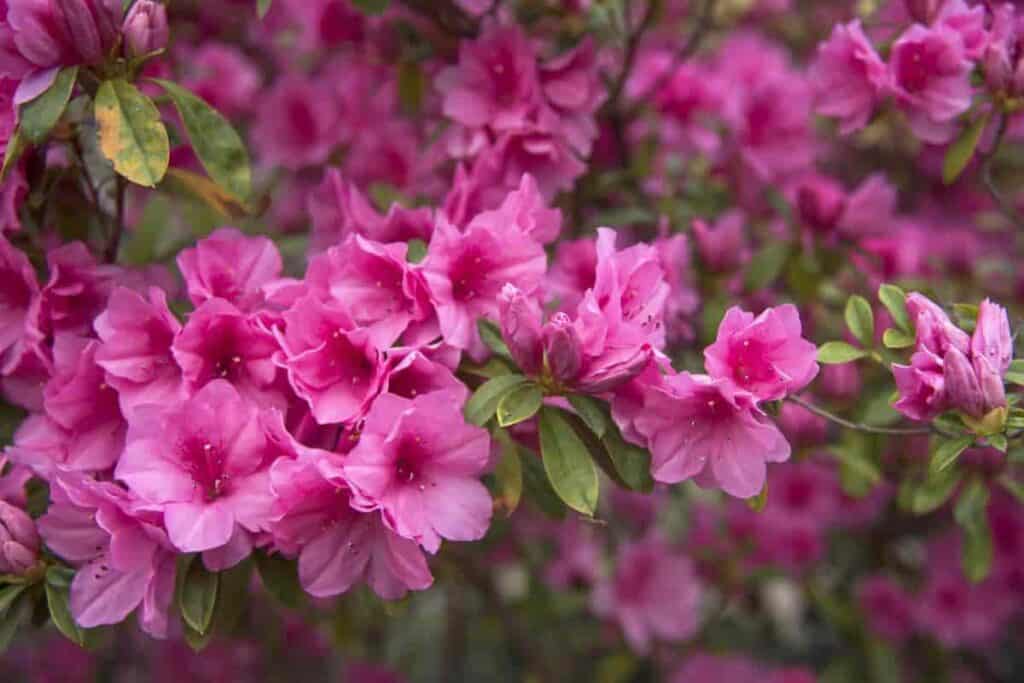Irrigation
You can expect little rainfall in the Southwest this month, so irrigation is important.
Most deciduous trees and shrubs have not yet dropped their leaves and should not be allowed to dry out.

Rhododendrons, azaleas, camellias, laurel, and other hardy broad-leaved evergreens will show ill effects toward the end of a warm, dry season unless you keep them watered.
Apply Miticides
Hose off their foliage to get rid of dust, spider mites, and thrips.
If your plants are badly infested, spray with one of the miticides like malathion, kelthane, or aramite.
Feed Complete Plant Food
Feed pines, junipers, yews, cypress, and other coniferous evergreens with complete plant food and make sure they get plenty of water.
Feed roses too, but not tropical plants. Resulting in soft growth would make them more susceptible to injury from frost.
Plant Plenty Of Bulbs
Plant plenty of bulbs this month and next for a gardenful of color and fragrance next spring.
Bulbs can be tucked into many small open spaces in the garden, are equally at home among shrubbery and perennials, in plant boxes, and combined with annuals.
Freesias, sparaxis, ixias, and several other small bulbs which produce brightly colored flowers on slender, wiry stems create lovely effects when set out with bedding plants.
Select And Plant Excellent Tulips
I have often heard that you can’t grow good tulips here. This is far from true.
If you select the right varieties, plant them deep enough in soil that has been enriched and spaded up to give the bulbs plenty of root room, keep the soil moist until the tops appear, and water generously, you can have just as fine a display of tulips as you will find anywhere.
About varieties, forget the old favorites you knew in the East.
Choose the modern ones that greatly improve the size, stem length, substance, and lasting quality. And buy tulips by name.
Some of the best in their color classes are:
- White City
- Santa Monica, an outstanding red
- Pink Supreme
- Pandion, a vivid purple
- Sunkist, deep yellow
Pre-cool your bulbs at 40° degrees Fahrenheit for several weeks for more uniform flowering and greater stem length.
The temperature in your household refrigerator (not in the freezing compartment) is just right. In Southern California and Arizona, wait a little longer before planting.
Check Dahlias For Signs Of Mosaic Virus
Check dahlias for signs of a mosaic virus, which are:
- Stunted growth
- Thick, curled leaves
- A mottled yellow color
The virus is carried in the sap and will carry over in the tubers, so you must destroy affected plants.
It is spread by leafhoppers which come into the garden from weedy areas. To control, spray with DDT.
Fertilize Lawns
Fertilize lawns to promote the growth of dichondra and cool weather grasses like Kentucky bluegrass and the bents.
Apply PAX to prevent crabgrass seed from germinating next spring. Bermuda. St. Augustine and zoysia grasses brown in cold weather.
You can either overplant with cool weather grasses or dye your turf to green it up.
When growth stops, mow close, weed, trim, and groom the lawn. Then apply the dye with a sprayer.
A good dye will keep your lawn green all winter, but there are inferior products on the market which are not color-fast.
Your best insurance is to consult a reliable dealer and choose a brand you can trust.
44659 by R. D. Westcott